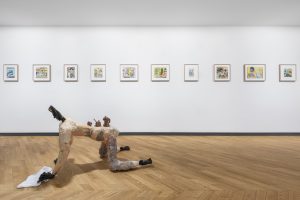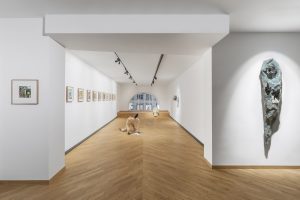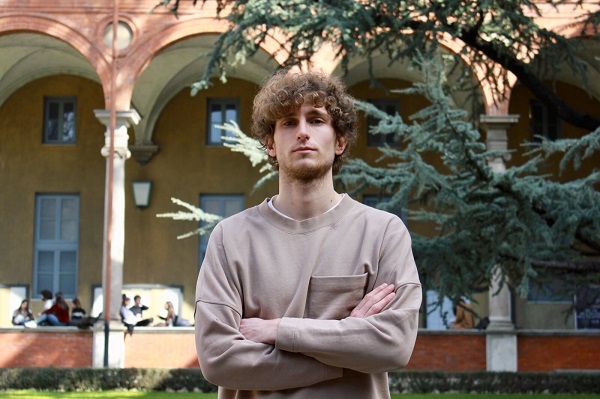The brilliant solo show “Sulle colazioni e sulle imboscate. (On breakfasts and ambushes)” by Francesco Snote (1991) inaugurated L.U.P.O – Lorenzelli Upcoming Projects Organization – space in Milan on September 14th, under the guidance of the young Massimiliano Lorenzelli (fourth generation of the historic family of gallery owners) with the co-director Pier Francesco Petracchi and the gallery manager Federico Brayda-Bruno.
The corpus of works is presented as ranging between sculptures and watercolours and centered around the evangelical character of Lazarus, resurrected by Jesus. All of this is to be considered with the surreal accompanying text structured in the form of a dialogue between Lazarus and the osteopath Professor Arturo M ., the personification of the famous sculptor Arturo Marini, in Piazza San Babila in Milan. But this sense of constant oscillation between mystery and wonder, which acts as the backbone of the entire exhibition structure, appears “clear” (perhaps a paradoxical term in such a scenario) starting from the title itself, “Sulle colazioni e sulle imboscate”, referring almost to an enigmatic and fantastic poem. Inevitably, the need to decipher that mystery, coded on five simple words, is configured as a prevailing desire. And the answer can only be found in the meanings hidden between dazzling ceramics and dialogues in a suspended time. Firstly, you have “breakfast”, the first moment with which the day begins and, in a broad sense, the first real transition from a state of sleep unconsciousness to that of “metaphorical” awakening. The term is not accidental. What Snote wants to refer to through the narrative device of the ghost of Lazarus is this sense of slow recovery from the state in which the current pandemic has confined us so far. Subsequently, there are “ambushes”, to be understood instead as that flow of unexpected encounters and deviations that everyone necessarily goes through in the course of the existence and which are exemplified in the alienating humanoids that animate the spaces. Despite the inherent risk of such a far-reaching issue, the narrative is developed without the slightest hint of rhetoric but rather based on a continuous inscrutability and amazement. A bursting flow of sensations that are difficult to contain from the moment you begin to take your first steps and find yourself in front of the ceramic and clay sculpture “Capocollo è un attimo” in dialogue, on the opposite wall, with the hanged “Baco sottoeroico”. This is charged with a character of strong and clearer religiosity, both for the positioning (like a cross) and for details such as the right hand in a blessing pose with the three fingers raised. Instead, the left hand is caught in the act of holding up a handkerchief bearing the artist’s initials, thus introducing an autobiographical dimension. The coating wrapping the figure and referring to Lazarus himself also contributes to stratify this aura of sacredness. On the back wall, there is instead a series of six bronze busts relating, as indicated directly by the titles, to figures commonly associated with the popular tradition – including “Scemo del villaggio” and “La veggente” – and resting on an outgoing support from the wall to establish an involvement with the viewer. Beyond the skill with which Snote structures this stratification of meanings, expression of a surreal universe and an acrobatic oscillation between the kingdom of the dead and the living, one cannot but be struck by the manual ability with which the works were created, characterized by a sparkling materiality thanks to the skilful use of materials such as synthetic ceramic, clay and iron powder. To complete the first room and introduce the dialogue between different mediums, here is “Presagio con fumata” a watercolour on paper emphasizing the aforementioned technical skill. Through careful processing, the result emerges as sharper with denser and less nuanced shades with which fantastic scenes are presented and at times of ironic re-interpretation of the figure of Lazarus and various characters set in almost metaphysical environments and outlining a concentration of fantasies that is configured as a sort of invitation to a deeper reconsideration of the nature of one’s problems. A figuration on which the 10 watercolours in the next room concentrate in conjunction with 3 other sculptural subjects that do nothing but underline this aura of transcendence and mystery. Among these stand out “Gorgomoro ambimancino” – crawling humanoid with which Snote adds an ironic variation to the breakfast motif, whose most usual objects are placed directly on its back – and “Sveglio o che si appropinqua 2” which frontally welcomes the visitor with a sense of solemn contemplation.
Overall, Snote successfully manages to develop in an intimate and non-trivial way a theme that is now inseparable from our daily life, structuring an almost fluctuating narrative system in a continuous alternation between transcendent and earthly, wonder and doubt. A feeling that emerges from some passages of the dialogue that lead to questioning the “will” of awakening Lazarus. It reads: “I thought that I would feel nostalgia for my place of origin and that, if I came back, I could appreciate even the slightest grain of sand that I previously considered insignificant. Well, it wasn’t like that”. Almost an invitation to reflect on whether the awakening from this drama has really helped in the development of a deeper and less obvious sensitivity or if instead there is only rubble. One wonders, are you sure that Lazarus wanted to be awakened or rather to “fall asleep”?
Gabriele Medaglini
Info:
Francesco Snote. Sulle colazioni e sulle imboscate
14/09/2021 – 31/10/2021
L.U.P.O. gallery
Corso Buenos Aires 2 – Milano




 For all the images: Exhibition view – Sulle Colazioni e sulle Imboscate – Francesco Snote. Courtesy of L.U.P.O. – Lorenzelli Projects
For all the images: Exhibition view – Sulle Colazioni e sulle Imboscate – Francesco Snote. Courtesy of L.U.P.O. – Lorenzelli Projects

With a specialist degree in Economics and Management of Cultural Heritage, passionate about the field of Contemporary art, its economic dimension and, more generally, the dynamics characterizing the art market, Gabriele has gained experience over time in contexts such as contemporary art galleries, start-ups and Art Advisory. He currently works in the Art-Rite auction house as an assistant in the department of Modern and Contemporary art.






NO COMMENT